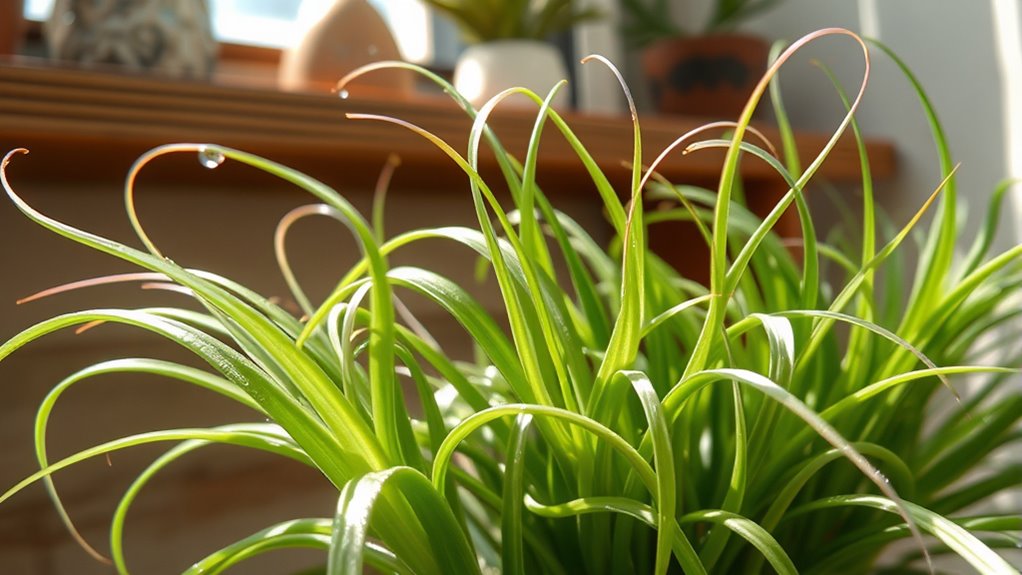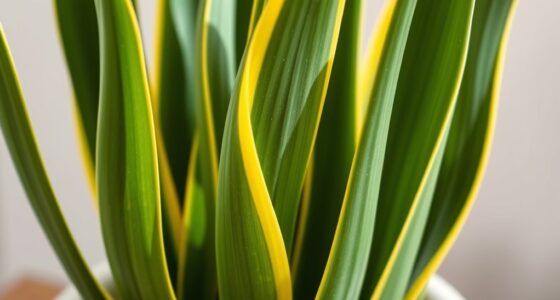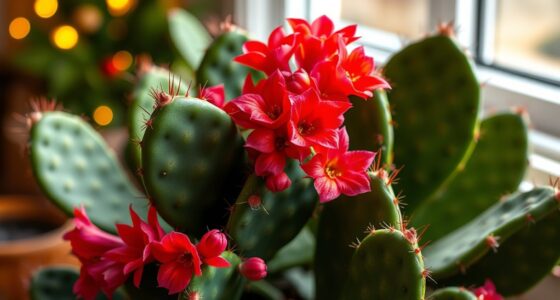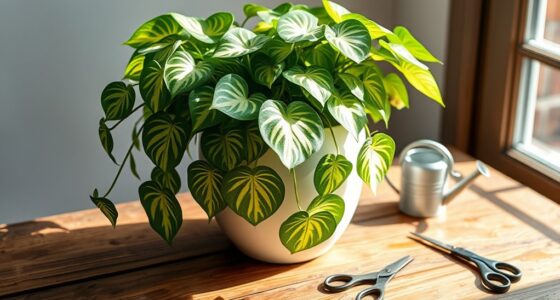To care for your air plants (Tillandsia), give them bright, indirect light, preferably near east or west-facing windows, and make certain of good air circulation to prevent mold. Water them weekly by soaking in room-temperature water for 20-30 minutes, then dry thoroughly. Keep them in temperatures between 50°F and 90°F and avoid frost. Regularly groom and separate pups to encourage healthy growth. Keep exploring for more tips to keep your plants thriving.
Key Takeaways
- Provide bright, indirect light and ensure good airflow to prevent moisture buildup and promote healthy growth.
- Soak air plants in room-temperature water weekly for 20-30 minutes, then dry thoroughly to avoid rot.
- Maintain indoor temperatures between 50°F and 90°F, protecting from frost and extreme heat sources.
- Regularly groom by removing dried leaves and separating pups to encourage new growth.
- Avoid direct summer sunlight and ensure proper watering, air circulation, and care during blooming for vibrant flowers.
Providing the Right Light and Air Circulation

To keep your air plants healthy, it’s vital to provide them with the right light and guarantee proper air circulation. Place your Tillandsia where they receive bright, indirect light, such as east or west-facing windows, to mimic their natural environment. Avoid direct summer sunlight, which can cause dehydration. Use full-spectrum fluorescent bulbs if natural light is limited, positioning your plants no more than 36 inches from the source and providing a 12-hour daily light cycle. Ensuring proper air quality can significantly impact their health and longevity. Good air circulation is essential; don’t keep your plants in enclosed containers. Open terrariums or globes regularly to prevent moisture buildup and promote drying. Proper remote work environments can enhance your plant care routine by giving you the time and space to tend to your plants regularly. After watering, rotate your plants to ensure even exposure and drying within three hours in a well-ventilated space, helping prevent rot and dehydration. Additionally, maintaining appropriate humidity levels can support their overall health and prevent dehydration. Incorporating air circulation strategies, such as gentle fan use or strategic placement, can further improve airflow around your plants.
Maintaining Optimal Watering and Hydration Practices

Proper watering habits are key to keeping your air plants healthy and vibrant. To guarantee thorough hydration, soak your plants in room-temperature water for 20-30 minutes once a week, using safe water sources like tap, rain, or spring water. After soaking, gently shake off excess water and dry the plant completely in bright, indirect light to prevent rot. Incorporating diverse beach experiences into your routine can help you better understand environmental impacts on plant care. In dry or warm environments, mist your air plants every few days to maintain moisture levels. Make sure your plants are dry within hours to promote healthy growth and avoid fungal issues. Consistent hydration practices help prevent overwatering and dehydration, ensuring your air plants thrive. Additionally, understanding air circulation can help prevent mold and rot, so place your plants where they receive good airflow. Good ventilation is essential for reducing humidity around your plants and promoting healthy growth. Proper ventilation not only supports the health of your plants but also assists in maintaining optimal temperature regulation around them. Recognizing the importance of light conditions can further enhance your air plant care routine.
Managing Temperature and Environmental Conditions
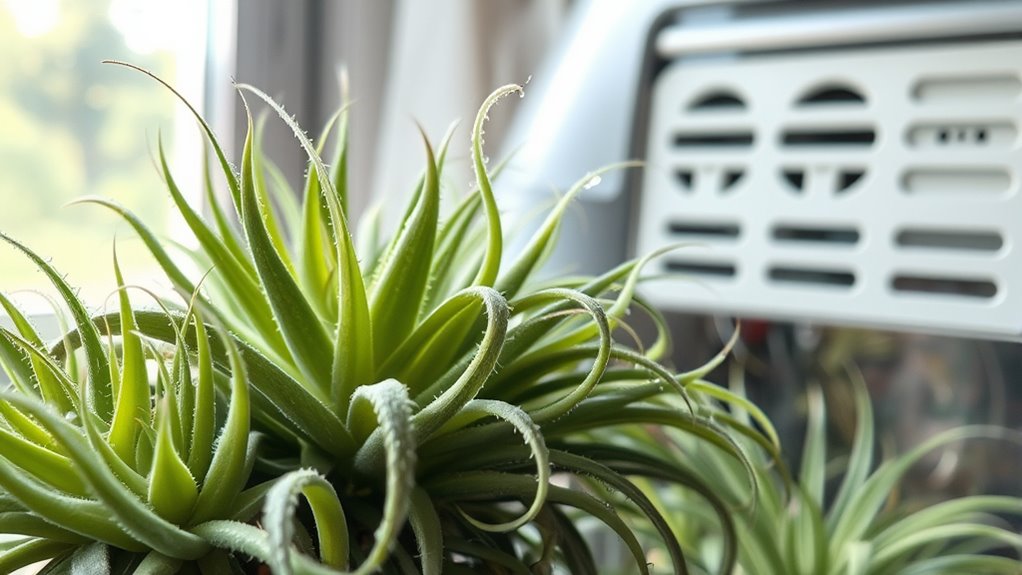
Maintaining stable temperature and environmental conditions is essential for keeping your air plants healthy. Keep indoor temperatures between 50°F and 90°F to promote growth and prevent stress. Protect your Tillandsia from frost and avoid exposing them to temperatures below 40°F, which can cause frost damage or plant death. When moving outdoor, gradually acclimate them to outdoor conditions to prevent shock from sudden temperature fluctuations. Keep plants away from heat sources and air vents that can cause dehydration or temperature swings. During brief outdoor exposure, ensure temperatures don’t dip below 40°F. Proper management of environmental conditions helps your air plants build cold tolerance and reduces plant stress. Use this table as a quick reference:
| Temperature Range | Frost Protection | Environmental Tips |
|---|---|---|
| 40°F – 50°F | Cover or bring inside | Avoid drafts and heat sources |
| 50°F – 90°F | Ideal for growth | Gradually acclimate outdoors |
| Above 90°F | Provide shade | Ensure proper watering |
| Below 40°F | Frost damage risk | Bring indoors immediately |
| During fluctuations | Minimize stress | Maintain consistent temps |
Additionally, choosing the right location with proper airflow can prevent moisture buildup and fungal issues, which are important considerations in plant health.
Supporting Growth Through Grooming and Propagation
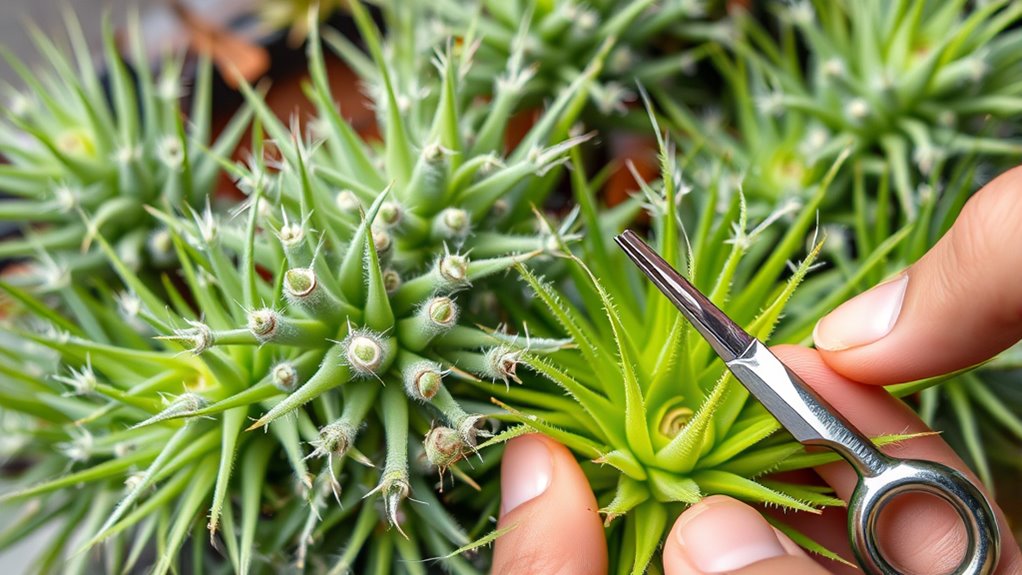
Grooming and propagation are essential steps in ensuring your air plants stay healthy and vibrant. Regularly remove dried leaves by gently pulling or trimming at an angle to promote healthy growth. Self Watering Plant Pots can help maintain consistent moisture levels, supporting overall plant health.
When pups reach at least one-third the size of the parent, separate them using twisting or cutting techniques to encourage new plants. Proper grooming, including snipping dried leaf tips and pruning roots, helps maintain their appearance and overall health.
You can leave pups to form clumps or separate them to expand your collection or create new plants. Supporting growth through these practices enhances flowering, offsets development, and improves plant care.
- Remove dried leaves to prevent disease
- Separate pups at the right size for propagation
- Prune roots for better airflow
- Trim offsets to encourage healthy growth
- Groom regularly for ideal plant health
Understanding the Life Cycle and Blooming of Air Plants
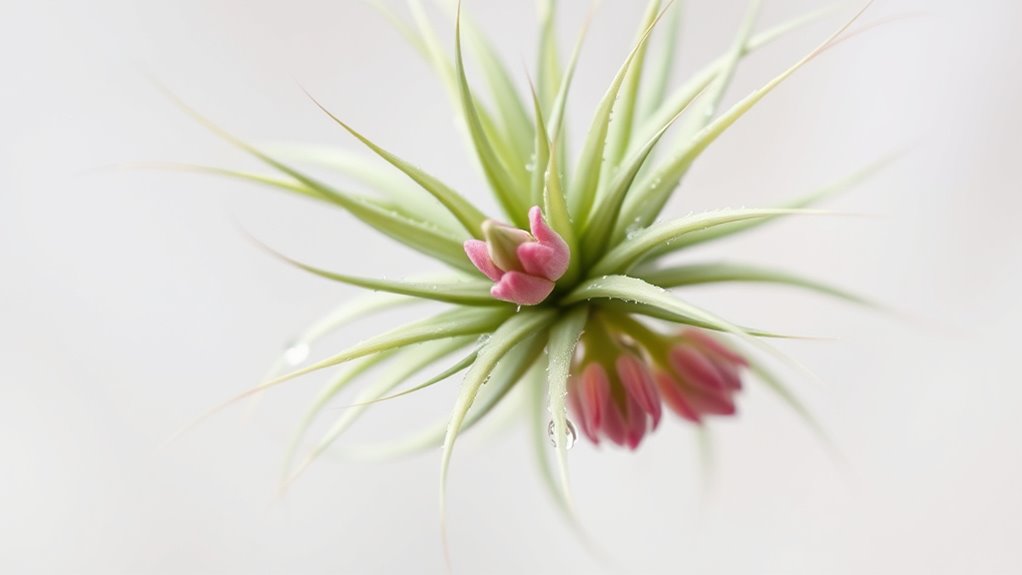
Air plants, or Tillandsia, have a unique life cycle that culminates in a single blooming event, usually once in their lifetime. During the blooming period, you’ll see vibrant flowers lasting from days to several months, depending on the species.
Air plants bloom once in a lifetime with vibrant flowers that last from days to months.
After flowering, the mature plant begins to produce pups—clones that appear when the plant is about one-third to half its size. These pups are part of the plant’s propagation process and can be separated or left to form clumps. Proper watering techniques during this stage are essential to support pup growth and overall health. Understanding the life cycle of air plants helps in optimizing their care and ensuring successful blooming. Recognizing the environmental conditions necessary for each stage can further improve plant health and flowering success.
The original plant gradually dies after flowering, but its pups continue the growth cycle and extend the plant’s overall lifespan.
Most blooming occurs between mid-winter and mid-summer, with purple flowers being common. Understanding this cycle helps you care for your air plant throughout its flowering and growth phases. Proper watering and light conditions during these stages are crucial for a healthy bloom and subsequent pup development, especially since plant care varies depending on the stage of the life cycle.
Frequently Asked Questions
How Often Should I Water My Tillandsia Air Plant?
You’re wondering how often to water your tillandsia air plant. Typically, you should soak it once a week for about 30 minutes.
In dry or warm environments, mist it every few days to keep it moist.
Remember, after watering, shake off excess water and let it dry completely within three hours to prevent rot.
Adjust watering based on humidity and always guarantee it dries thoroughly.
How Do You Care for Potted Tillandsia?
To care for your potted tillandsia, place it in bright, indirect light or under full-spectrum fluorescent lights within 36 inches.
Water it weekly by soaking in room temperature water for 20-30 minutes, then shake off excess moisture and dry it thoroughly.
Guarantee good air circulation to prevent rot, keep it in temperatures between 50-90°F, and regularly remove dried leaves or dead roots to promote healthy growth.
How Do You Take Care of Air Plants Indoors?
You might think air plants need little care, but they thrive with proper attention. Keep them in bright, indirect light or under full-spectrum bulbs, no more than 36 inches away.
Water weekly by soaking for 20-30 minutes, then dry thoroughly. Guarantee good air circulation to prevent rot, and maintain indoor temps between 50-90°F.
Mist in dry environments, and fertilize monthly for healthy, vibrant plants.
How Do I Know if My Air Plant Is Happy?
You’ll know your air plant is happy when its leaves are wide, flat, and vibrant, showing it’s well-hydrated. Bright blooms or new pups also signal good health.
If the leaves aren’t wrinkled or curled, and the plant stands upright without brown or dead parts, it’s thriving.
Consistent growth and the absence of stress signs confirm your air plant feels good in its environment.
Conclusion
Caring for air plants is like tending a delicate dance—you give them light, water, and love, and they thrive. I once placed mine in a sunny windowsill, watching it bloom after months of patience, much like waiting for a sunrise that promises new beginnings. Remember, your attentive care transforms these simple plants into living art. With each gentle touch and mindful step, you’re nurturing a tiny miracle that brightens your world.
